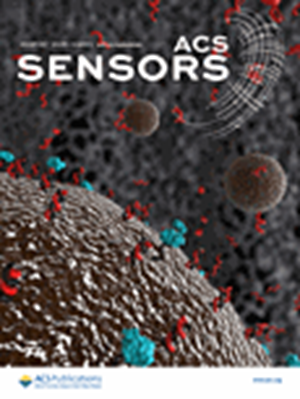具有肌氨酸分支的工程防污肽用于真实生物样品中HER2生物标志物的鲁棒电化学检测。
IF 8.2
1区 化学
Q1 CHEMISTRY, ANALYTICAL
引用次数: 0
摘要
在复杂的生物基质中,电化学生物传感器表面发生的非特异性吸附现象对异质生物样品中目标的精确检测提出了相当大的挑战。此外,生物流体中蛋白质水解酶的存在也会影响利用天然蛋白质或多肽的生物传感装置的稳定性。因此,必须开发能够有效地减少实际生物样品中此类影响的传感装置。在此,我们设计了一种具有强防污能力的肌氨酸支链肽(SBCP),以避免生物污垢,并增强了抗蛋白酶水解的稳定性。该肽由锚定序列(CPPPP)、防污序列(EK(Sar)EK(Sar)EK(Sar)EK(Sar) EK(Sar))和识别序列(HLTVSPWY)组成。通过在电极表面电沉积聚(3,4-乙烯二氧噻吩)(PEDOT)和聚(去甲肾上腺素)(PNE),然后电沉积金纳米粒子和SBCP自组装,开发了一种电化学生物传感器。利用含有肿瘤生物标志物人表皮生长因子受体2 (HER2)特异性识别肽序列的SBCP构建的生物传感器能够在1.0 pg mL-1 ~ 1.0 μg mL-1的浓度范围内灵敏地检测到靶点HER2,检测限为0.37 pg mL-1。此外,该生物传感器具有防污能力,能够准确检测人血清中的靶标,与ELISA试剂盒的检测结果高度一致。这些结果表明,基于工程肽的生物传感器具有良好的实际应用潜力。本文章由计算机程序翻译,如有差异,请以英文原文为准。
Engineered Antifouling Peptides with Sarcosine Branches for Robust Electrochemical Detection of the HER2 Biomarker in Real Biological Samples.
In complex biological matrices, the nonspecific adsorption phenomena occurring on the surfaces of electrochemical biosensors represent a considerable challenge for the precise detection of targets in heterogeneous biological samples. Furthermore, the presence of protein hydrolases in biofluids also affects the stability of biosensing devices utilizing natural proteins or peptides. It is therefore imperative to develop sensing devices capable of effectively minimizing such effects in real biological samples. Herein, we engineered a sarcosine branch-chain peptide (SBCP) with a strong antifouling capability to avoid biofouling and enhanced stability to resist hydrolysis by proteases. The peptide is composed of three sections: an anchoring sequence (CPPPP), an antifouling sequence (EK(Sar)EK(Sar)EK(Sar)EK(Sar)), and a recognition sequence (HLTVSPWY). An electrochemical biosensor was developed through the electrodeposition of poly(3,4-ethylenedioxythiophene) (PEDOT) incorporated with poly(norepinephrine) (PNE) on an electrode surface, followed by the electrodeposition of gold nanoparticles and the self-assembly of SBCP. The biosensor constructed using the SBCP containing a specific recognizing peptide sequence for the cancer biomarker human epidermal growth factor receptor 2 (HER2) was capable of sensitively detecting target HER2, within the concentration range of 1.0 pg mL-1 to 1.0 μg mL-1 and with a limit of detection of 0.37 pg mL-1. Moreover, the biosensor demonstrated antifouling ability and the capacity to accurately detect the target in human serum, exhibiting a high degree of concordance with the assaying results of ELISA kits. These findings suggest that the biosensor based on the engineered peptides possesses promising potential for practical applications.
求助全文
通过发布文献求助,成功后即可免费获取论文全文。
去求助
来源期刊

ACS Sensors
Chemical Engineering-Bioengineering
CiteScore
14.50
自引率
3.40%
发文量
372
期刊介绍:
ACS Sensors is a peer-reviewed research journal that focuses on the dissemination of new and original knowledge in the field of sensor science, particularly those that selectively sense chemical or biological species or processes. The journal covers a broad range of topics, including but not limited to biosensors, chemical sensors, gas sensors, intracellular sensors, single molecule sensors, cell chips, and microfluidic devices. It aims to publish articles that address conceptual advances in sensing technology applicable to various types of analytes or application papers that report on the use of existing sensing concepts in new ways or for new analytes.
 求助内容:
求助内容: 应助结果提醒方式:
应助结果提醒方式:


